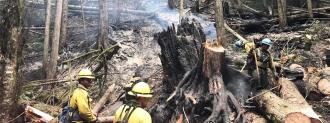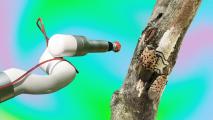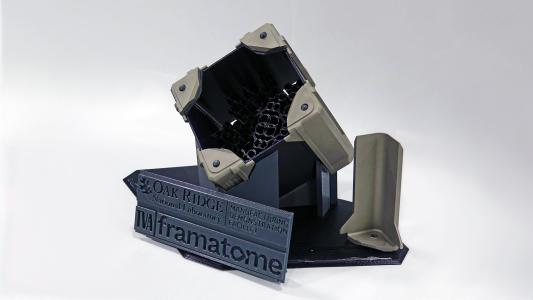After fires ripped through Washington State’s Olympic National Forest in 2018, firefighters found evidence of a tree heist gone wrong — sawed-off stumps of protected bigleaf maple trees.
They turned to tree DNA — a new area of forensic evidence — to connect the stumps with the missing tree and caught the poachers red-handed.
The backstory: In the United States, tree poaching is surprisingly common. Bigleaf maple and yellow cedar are highly sought after for their beautiful wood, often used in musical instruments, art, and fine furniture. A single tree might be worth thousands of dollars, depending on its size and woodgrain patterning.
A few shredded stumps — all that remains of the poached trees — are sometimes the only sign that a thief was present.
Prized trees, in mostly unguarded forests, make a tempting target for timber thieves, and it is hard to nab a tree poacher after the fact. A few shredded stumps — all that remains of the poached trees — are sometimes the only sign that a thief was present.
What’s more, many tree species can be lawfully harvested, if they are on private land or harvested with a permit. Side-by-side, it is impossible to tell the difference between black-market timber and a log that was legally harvested.
Side-by-side, it is impossible to tell the difference between black-market timber and a log that was legally harvested.
But tree DNA can connect a log for sale on the market to a stump in the forest.
What went down: The 2018 Maple Fire destroyed 3,300 acres of Washington state’s Olympic National Forest. In the remains, local officials found a group of suspicious burning maple tree stumps. Someone had clearly used a saw to chop them down before the fire.
The law enforcement agents got to work. They collected genetic samples from dozens of logs, hoping the tree DNA could be used to match timber to the tree stumps. They sent the samples to Richard Cronn, a research geneticist with the U.S. Forest Service (USFS).
He used genetic analysis to match the Olympic Forest DNA to lumber sold to a local mill by defendant Justin Andrew Wilke. Wilke claimed he had harvested the three bigleaf maple trees legally, from private land. But genetic evidence connected the wood to the stumps.
“The DNA analysis was so precise that it found the probability of the match being coincidental was approximately one in one undecillion (one followed by 36 zeros),” prosecutors said.
“This whole story is 100% a testament to the detailed investigating skills of our Forest Service law enforcement agents,” Cronn says, explaining that collecting wood samples from the right lumber was like finding a needle in a haystack. “They showed the determination to try to get an answer. They really invested a lot of time and took detailed notes.”
According to a statement from the U.S. Attorney’s Office for Western Washington, Cronn testified that the wood Wilke sold was a genetic match to the remnants of three poached maple trees investigators recovered in the Elk Lake region — convincing the jury that Wilke’s timber had been stolen.
“The DNA analysis was so precise that it found the probability of the match being coincidental was approximately one in one undecillion (one followed by 36 zeros),” prosecutors said.
The case marks the first time in federal criminal proceedings that tree DNA has been used to convict a tree poacher, the Associated Press reports.
The mind of a poacher: Wilke and his fellow conspirators had an elaborate and calculated system for poaching desirable trees, according to court documents. It involved sneaking into the forest, peeling the bark aside to assess the wood, and forging documents to convince sawmills it was legal, The Washington Post reports.
But what they didn’t anticipate was a bee nest near the base of the tree. This is where the story gets muddled and can’t be confirmed with evidence. Wilke says he didn’t start the Maple Fire, which cost the state about $4.2 million to put out. But prosecutors say Wilke doused the bee nest with gasoline and set it alight. Ultimately, the jury did not convict Wilke of starting the fire.
“When people steal trees from our public lands, they are stealing a beautiful and irreplaceable resource from all of us and from future generations,” Tessa M. Gorman, acting U.S. Attorney, said. “That theft, coupled with the sheer destruction of the forest fire that resulted from this activity, warrants federal criminal prosecution.”
Future genetics: While genetic analysis opens up more opportunities to connect a log on the market with a damaged stump, law enforcement still needs to find both the stump and the timber. If a tree was poached deep in a national park, finding the stump could be next to impossible — poachers are betting on it.
But not long after the Maple Fire investigation began, a group of volunteers for Adventure Scientists started helping to build a tree DNA database of desirable targets for poachers, which I previously reported. They sent those samples to Cronn. The idea was that by comparing lumber of unknown origin with a reference database of tree DNA throughout the country, scientists could hone in on where the tree likely came from.
Instead of needing to find a tree stump in the forest and a suspicious log for sale on the market, researchers could use a comparison to the reference database to identify the likely origin of the timber, such as a National Park or National Forest.
Cronn had already finished his analysis for the Wilke case when Adventure Scientists sent him their samples. He had explored the Olympic peninsula, collecting genetic samples and building a mini-database of his own. But, because Adventure Scientists drew from the collective effort of many volunteer citizen scientists, their database was much larger in scope. It spanned the entire bigleave maple range. So, Cronn checked his work again with the new database. Using the Adventure Scientists’ data, he crunched the numbers, and came up with the same conclusions.
“It basically confirmed everything that we said, for this particular case. And what it ended up showing us was really how useful this particular DNA fingerprinting test would be across the range of bigleaf maple,” he said.
Cronn calls it an “on the shelf” product — something that researchers can use in future cases when the origin of a piece of timber is called into question.
We’d love to hear from you! If you have a comment about this article or if you have a tip for a future Freethink story, please email us at tips@freethink.com.






